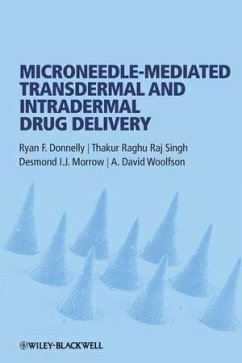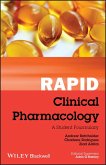Ryan F Donnelly, Thakur Raghu Raj Singh, Desmond I J Morrow, A David Woolfson
Microneedle-Mediated Transdermal and Intradermal Drug Delivery
Mitarbeit: Donnelly, Ryan F.; Singh, Thakur Raghu Raj; Morrow, Desmond I. J.; Woolfson, A. David
Ryan F Donnelly, Thakur Raghu Raj Singh, Desmond I J Morrow, A David Woolfson
Microneedle-Mediated Transdermal and Intradermal Drug Delivery
Mitarbeit: Donnelly, Ryan F.; Singh, Thakur Raghu Raj; Morrow, Desmond I. J.; Woolfson, A. David
- Gebundenes Buch
- Merkliste
- Auf die Merkliste
- Bewerten Bewerten
- Teilen
- Produkt teilen
- Produkterinnerung
- Produkterinnerung
One of the latest techniques in drug delivery, microneedles are used for administering a wide range of drug substances used to treat various medical conditions. Thorough background information is included providing a history of the field. Various methods used to produce micorneedles are described as well as a snapshot of the future directions within the industry. Written by highly qualified authors, this new text is the only title providing a comprehensive review of microneedle research in the fields of transdermal and intradermal drug delivery.
Andere Kunden interessierten sich auch für
![Mann's Pharmacovigilance Mann's Pharmacovigilance]() Mann's Pharmacovigilance392,99 €
Mann's Pharmacovigilance392,99 €![Prescribing Scenarios at a Glance Prescribing Scenarios at a Glance]() Emma BakerPrescribing Scenarios at a Glance41,99 €
Emma BakerPrescribing Scenarios at a Glance41,99 €![The Textbook of Pharmaceutical Medicine The Textbook of Pharmaceutical Medicine]() The Textbook of Pharmaceutical Medicine357,99 €
The Textbook of Pharmaceutical Medicine357,99 €![Prescribing at a Glance Prescribing at a Glance]() Sarah RossPrescribing at a Glance54,99 €
Sarah RossPrescribing at a Glance54,99 €![Antimicrobial Therapeutics Reviews, Volume 1213 Antimicrobial Therapeutics Reviews, Volume 1213]() Antimicrobial Therapeutics Reviews, Volume 1213162,99 €
Antimicrobial Therapeutics Reviews, Volume 1213162,99 €![Rapid Clinical Pharmacology Rapid Clinical Pharmacology]() Andrew BatchelderRapid Clinical Pharmacology38,99 €
Andrew BatchelderRapid Clinical Pharmacology38,99 €![An Introduction to Statistics in Early Phase Trials An Introduction to Statistics in Early Phase Trials]() Steven JuliousAn Introduction to Statistics in Early Phase Trials131,99 €
Steven JuliousAn Introduction to Statistics in Early Phase Trials131,99 €-
-
-
One of the latest techniques in drug delivery, microneedles are used for administering a wide range of drug substances used to treat various medical conditions. Thorough background information is included providing a history of the field. Various methods used to produce micorneedles are described as well as a snapshot of the future directions within the industry. Written by highly qualified authors, this new text is the only title providing a comprehensive review of microneedle research in the fields of transdermal and intradermal drug delivery.
Hinweis: Dieser Artikel kann nur an eine deutsche Lieferadresse ausgeliefert werden.
Hinweis: Dieser Artikel kann nur an eine deutsche Lieferadresse ausgeliefert werden.
Produktdetails
- Produktdetails
- Verlag: Wiley & Sons
- 2. Aufl.
- Seitenzahl: 216
- Erscheinungstermin: 5. März 2012
- Englisch
- Abmessung: 231mm x 152mm x 15mm
- Gewicht: 408g
- ISBN-13: 9780470654897
- ISBN-10: 0470654899
- Artikelnr.: 34158378
- Herstellerkennzeichnung
- Libri GmbH
- Europaallee 1
- 36244 Bad Hersfeld
- gpsr@libri.de
- Verlag: Wiley & Sons
- 2. Aufl.
- Seitenzahl: 216
- Erscheinungstermin: 5. März 2012
- Englisch
- Abmessung: 231mm x 152mm x 15mm
- Gewicht: 408g
- ISBN-13: 9780470654897
- ISBN-10: 0470654899
- Artikelnr.: 34158378
- Herstellerkennzeichnung
- Libri GmbH
- Europaallee 1
- 36244 Bad Hersfeld
- gpsr@libri.de
Ryan F. Donnelly, Senior Lecturer in Pharmaceutics, School of Pharmacy, Queen's University Belfast, UK Thakur Raghu Raj Singh, Lecturer in Pharmaceutics, School of Pharmacy, Queen's University Belfast, UK Desmond I.J. Morrow, Honorary Research Fellow, School of Pharmacy, Queen's University Belfast, UK A. David Woolfson, Chair in Pharmaceutics and Head of the School of Pharmacy, Queen's University Belfast, UK
Preface, ix
About the Authors, xiii
1 Transdermal Drug Delivery, 1
1.1 Genesis of transdermal drug delivery, 1
1.2 Skin anatomy, 2
1.2.1 The epidermis, 2
1.2.2 The stratum corneum, 4
1.2.3 The dermis, 6
1.2.4 Skin appendages, 6
1.3 Routes to percutaneous drug absorption, 7
1.4 Facilitated transdermal drug delivery, 11
1.4.1 Cryopneumatic and photopneumatic technologies, 12
1.4.2 Sonophoresis (low-frequency ultrasound), 12
1.4.3 Iontophoresis, 13
1.4.4 Electroporation, 14
1.4.5 Jet injection, 14
1.4.6 Microneedles, 15
References, 15
2 Microneedles: Design, Microfabrication and Optimization, 20
2.1 Introduction, 20
2.2 Methods of fabricating microneedles, 21
2.2.1 Microfabrication of silicon microneedles, 22
2.2.2 Microfabrication of metal and other types of MNs, 31
2.2.3 Microfabrication of polymeric microneedles, 34
2.3 Optimization to MN design for transdermal drug delivery, 46
2.4 Conclusion, 49
References, 51
3 Microneedle Applicator Designs for Transdermal Drug Delivery
Applications, 57
3.1 Introduction, 57
3.2 Considerations of microneedle applicators designs, 72
3.3 Conclusion, 76
References, 76
4 Transdermal Delivery Applications, 79
4.1 Introduction, 79
4.2 Transdermal drug delivery, 79
4.2.1 Partition co-efficient between 1 and 3, 80
4.2.2 A relatively low melting point, 80
4.2.3 A molecular weight less than 500 Da, 81
4.2.4 Unionized, 81
4.3 Modulation of transdermal penetration using microneedles, 82
4.4 Transdermal delivery using solid microneedles, 83
4.4.1 Transdermal delivery of low molecular weight compounds (RMM < 600 Da)
in vitro using solid microneedles, 84
4.4.2 Transdermal delivery of low molecular weight compounds (RMM < 600 Da)
in vivo using solid microneedles, 86
> 600 Da) in vitro using solid microneedles, 88
> 600 Da) in vivo using solid microneedles, 89
4.5 Transdermal delivery using hollow microneedles, 91
4.5.1 Transdermal delivery of low molecular weight compounds (RMM < 600 Da)
in vitro using hollow microneedles, 91
4.5.2 Transdermal delivery of low molecular weight compounds (RMM < 600 Da)
in vivo using hollow microneedles, 92
> 600 Da) in vitro using hollow microneedles, 93
> 600 Da) in vivo using hollow microneedles, 93
4.6 Transdermal delivery using biodegradable microneedles, 96
4.6.1 Transdermal delivery of low molecular weight compounds in vitro
using biodegradable MN, 96
4.6.2 Transdermal delivery of low molecular weight compounds in vivo using
biodegradable MN, 98
4.6.3 Transdermal delivery of high molecular weight
compounds in vitro using biodegradable MN, 98
4.6.4 Transdermal delivery of high molecular weight compounds in vivo
using biodegradable MN, 100
4.7 Microneedles in combination with other enhancement strategies, 102
4.8 Conclusion, 105
References, 107
5 Microneedle-mediated Intradermal Delivery, 113
5.1 Introduction, 113
5.2 Vaccine delivery, 113
5.2.1 Vaccination, 113
5.3 Intradermal vaccination, 116
5.3.1 Skin structure, 117
5.3.2 Skin immune response, 117
5.3.3 Conventional strategies for intradermal vaccine delivery, 118
5.3.4 Coated microneedles, 120
5.3.5 'Poke and Patch' approaches, 129
5.3.6 Hollow microneedles, 131
5.3.7 Dissolving/biodegrading polymeric microneedles, 133
5.3.8 Epidermal gene delivery, 135
5.4 Intradermal delivery of photosensitizers for photodynamic therapy, 139
5.4.1 Microneedle-mediated intradermal delivery of 5-aminolevulinic acid
and derivatives, 141
5.4.2 Microneedle-mediated intradermal delivery of preformed
photosensitizers, 143
5.5 Intradermal delivery of nanoparticles, 144
5.6 Conclusion, 146
References, 147
6 Clinical Application and Safety Studies of Microneedles, 152
6.1 Introduction, 152
6.2 Clinical and safety consideration for MN application, 153
6.2.1 Sensation of pain, 153
6.2.2 Recovery of micropores and possibility of infection following
microneedle application, 155
6.2.3 Erythema, 156
6.2.4 Biocompatability and biodegradation of MN material, 157
6.3 Conclusion, 159
References, 160
7 Microneedles: Current Status and Future Perspectives, 164
7.1 Introduction, 164
7.2 Biological fluid sampling devices, 167
7.3 Ocular drug delivery, 172
7.4 Cosmetic applications, 175
7.5 Industrial perspectives, 177
7.6 Hydrogel-forming microneedle arrays, 179
7.7 Moving forwards, 181
7.8 Conclusion, 184
References, 185
Index, 188
About the Authors, xiii
1 Transdermal Drug Delivery, 1
1.1 Genesis of transdermal drug delivery, 1
1.2 Skin anatomy, 2
1.2.1 The epidermis, 2
1.2.2 The stratum corneum, 4
1.2.3 The dermis, 6
1.2.4 Skin appendages, 6
1.3 Routes to percutaneous drug absorption, 7
1.4 Facilitated transdermal drug delivery, 11
1.4.1 Cryopneumatic and photopneumatic technologies, 12
1.4.2 Sonophoresis (low-frequency ultrasound), 12
1.4.3 Iontophoresis, 13
1.4.4 Electroporation, 14
1.4.5 Jet injection, 14
1.4.6 Microneedles, 15
References, 15
2 Microneedles: Design, Microfabrication and Optimization, 20
2.1 Introduction, 20
2.2 Methods of fabricating microneedles, 21
2.2.1 Microfabrication of silicon microneedles, 22
2.2.2 Microfabrication of metal and other types of MNs, 31
2.2.3 Microfabrication of polymeric microneedles, 34
2.3 Optimization to MN design for transdermal drug delivery, 46
2.4 Conclusion, 49
References, 51
3 Microneedle Applicator Designs for Transdermal Drug Delivery
Applications, 57
3.1 Introduction, 57
3.2 Considerations of microneedle applicators designs, 72
3.3 Conclusion, 76
References, 76
4 Transdermal Delivery Applications, 79
4.1 Introduction, 79
4.2 Transdermal drug delivery, 79
4.2.1 Partition co-efficient between 1 and 3, 80
4.2.2 A relatively low melting point, 80
4.2.3 A molecular weight less than 500 Da, 81
4.2.4 Unionized, 81
4.3 Modulation of transdermal penetration using microneedles, 82
4.4 Transdermal delivery using solid microneedles, 83
4.4.1 Transdermal delivery of low molecular weight compounds (RMM < 600 Da)
in vitro using solid microneedles, 84
4.4.2 Transdermal delivery of low molecular weight compounds (RMM < 600 Da)
in vivo using solid microneedles, 86
> 600 Da) in vitro using solid microneedles, 88
> 600 Da) in vivo using solid microneedles, 89
4.5 Transdermal delivery using hollow microneedles, 91
4.5.1 Transdermal delivery of low molecular weight compounds (RMM < 600 Da)
in vitro using hollow microneedles, 91
4.5.2 Transdermal delivery of low molecular weight compounds (RMM < 600 Da)
in vivo using hollow microneedles, 92
> 600 Da) in vitro using hollow microneedles, 93
> 600 Da) in vivo using hollow microneedles, 93
4.6 Transdermal delivery using biodegradable microneedles, 96
4.6.1 Transdermal delivery of low molecular weight compounds in vitro
using biodegradable MN, 96
4.6.2 Transdermal delivery of low molecular weight compounds in vivo using
biodegradable MN, 98
4.6.3 Transdermal delivery of high molecular weight
compounds in vitro using biodegradable MN, 98
4.6.4 Transdermal delivery of high molecular weight compounds in vivo
using biodegradable MN, 100
4.7 Microneedles in combination with other enhancement strategies, 102
4.8 Conclusion, 105
References, 107
5 Microneedle-mediated Intradermal Delivery, 113
5.1 Introduction, 113
5.2 Vaccine delivery, 113
5.2.1 Vaccination, 113
5.3 Intradermal vaccination, 116
5.3.1 Skin structure, 117
5.3.2 Skin immune response, 117
5.3.3 Conventional strategies for intradermal vaccine delivery, 118
5.3.4 Coated microneedles, 120
5.3.5 'Poke and Patch' approaches, 129
5.3.6 Hollow microneedles, 131
5.3.7 Dissolving/biodegrading polymeric microneedles, 133
5.3.8 Epidermal gene delivery, 135
5.4 Intradermal delivery of photosensitizers for photodynamic therapy, 139
5.4.1 Microneedle-mediated intradermal delivery of 5-aminolevulinic acid
and derivatives, 141
5.4.2 Microneedle-mediated intradermal delivery of preformed
photosensitizers, 143
5.5 Intradermal delivery of nanoparticles, 144
5.6 Conclusion, 146
References, 147
6 Clinical Application and Safety Studies of Microneedles, 152
6.1 Introduction, 152
6.2 Clinical and safety consideration for MN application, 153
6.2.1 Sensation of pain, 153
6.2.2 Recovery of micropores and possibility of infection following
microneedle application, 155
6.2.3 Erythema, 156
6.2.4 Biocompatability and biodegradation of MN material, 157
6.3 Conclusion, 159
References, 160
7 Microneedles: Current Status and Future Perspectives, 164
7.1 Introduction, 164
7.2 Biological fluid sampling devices, 167
7.3 Ocular drug delivery, 172
7.4 Cosmetic applications, 175
7.5 Industrial perspectives, 177
7.6 Hydrogel-forming microneedle arrays, 179
7.7 Moving forwards, 181
7.8 Conclusion, 184
References, 185
Index, 188
Preface, ix
About the Authors, xiii
1 Transdermal Drug Delivery, 1
1.1 Genesis of transdermal drug delivery, 1
1.2 Skin anatomy, 2
1.2.1 The epidermis, 2
1.2.2 The stratum corneum, 4
1.2.3 The dermis, 6
1.2.4 Skin appendages, 6
1.3 Routes to percutaneous drug absorption, 7
1.4 Facilitated transdermal drug delivery, 11
1.4.1 Cryopneumatic and photopneumatic technologies, 12
1.4.2 Sonophoresis (low-frequency ultrasound), 12
1.4.3 Iontophoresis, 13
1.4.4 Electroporation, 14
1.4.5 Jet injection, 14
1.4.6 Microneedles, 15
References, 15
2 Microneedles: Design, Microfabrication and Optimization, 20
2.1 Introduction, 20
2.2 Methods of fabricating microneedles, 21
2.2.1 Microfabrication of silicon microneedles, 22
2.2.2 Microfabrication of metal and other types of MNs, 31
2.2.3 Microfabrication of polymeric microneedles, 34
2.3 Optimization to MN design for transdermal drug delivery, 46
2.4 Conclusion, 49
References, 51
3 Microneedle Applicator Designs for Transdermal Drug Delivery
Applications, 57
3.1 Introduction, 57
3.2 Considerations of microneedle applicators designs, 72
3.3 Conclusion, 76
References, 76
4 Transdermal Delivery Applications, 79
4.1 Introduction, 79
4.2 Transdermal drug delivery, 79
4.2.1 Partition co-efficient between 1 and 3, 80
4.2.2 A relatively low melting point, 80
4.2.3 A molecular weight less than 500 Da, 81
4.2.4 Unionized, 81
4.3 Modulation of transdermal penetration using microneedles, 82
4.4 Transdermal delivery using solid microneedles, 83
4.4.1 Transdermal delivery of low molecular weight compounds (RMM < 600 Da)
in vitro using solid microneedles, 84
4.4.2 Transdermal delivery of low molecular weight compounds (RMM < 600 Da)
in vivo using solid microneedles, 86
> 600 Da) in vitro using solid microneedles, 88
> 600 Da) in vivo using solid microneedles, 89
4.5 Transdermal delivery using hollow microneedles, 91
4.5.1 Transdermal delivery of low molecular weight compounds (RMM < 600 Da)
in vitro using hollow microneedles, 91
4.5.2 Transdermal delivery of low molecular weight compounds (RMM < 600 Da)
in vivo using hollow microneedles, 92
> 600 Da) in vitro using hollow microneedles, 93
> 600 Da) in vivo using hollow microneedles, 93
4.6 Transdermal delivery using biodegradable microneedles, 96
4.6.1 Transdermal delivery of low molecular weight compounds in vitro
using biodegradable MN, 96
4.6.2 Transdermal delivery of low molecular weight compounds in vivo using
biodegradable MN, 98
4.6.3 Transdermal delivery of high molecular weight
compounds in vitro using biodegradable MN, 98
4.6.4 Transdermal delivery of high molecular weight compounds in vivo
using biodegradable MN, 100
4.7 Microneedles in combination with other enhancement strategies, 102
4.8 Conclusion, 105
References, 107
5 Microneedle-mediated Intradermal Delivery, 113
5.1 Introduction, 113
5.2 Vaccine delivery, 113
5.2.1 Vaccination, 113
5.3 Intradermal vaccination, 116
5.3.1 Skin structure, 117
5.3.2 Skin immune response, 117
5.3.3 Conventional strategies for intradermal vaccine delivery, 118
5.3.4 Coated microneedles, 120
5.3.5 'Poke and Patch' approaches, 129
5.3.6 Hollow microneedles, 131
5.3.7 Dissolving/biodegrading polymeric microneedles, 133
5.3.8 Epidermal gene delivery, 135
5.4 Intradermal delivery of photosensitizers for photodynamic therapy, 139
5.4.1 Microneedle-mediated intradermal delivery of 5-aminolevulinic acid
and derivatives, 141
5.4.2 Microneedle-mediated intradermal delivery of preformed
photosensitizers, 143
5.5 Intradermal delivery of nanoparticles, 144
5.6 Conclusion, 146
References, 147
6 Clinical Application and Safety Studies of Microneedles, 152
6.1 Introduction, 152
6.2 Clinical and safety consideration for MN application, 153
6.2.1 Sensation of pain, 153
6.2.2 Recovery of micropores and possibility of infection following
microneedle application, 155
6.2.3 Erythema, 156
6.2.4 Biocompatability and biodegradation of MN material, 157
6.3 Conclusion, 159
References, 160
7 Microneedles: Current Status and Future Perspectives, 164
7.1 Introduction, 164
7.2 Biological fluid sampling devices, 167
7.3 Ocular drug delivery, 172
7.4 Cosmetic applications, 175
7.5 Industrial perspectives, 177
7.6 Hydrogel-forming microneedle arrays, 179
7.7 Moving forwards, 181
7.8 Conclusion, 184
References, 185
Index, 188
About the Authors, xiii
1 Transdermal Drug Delivery, 1
1.1 Genesis of transdermal drug delivery, 1
1.2 Skin anatomy, 2
1.2.1 The epidermis, 2
1.2.2 The stratum corneum, 4
1.2.3 The dermis, 6
1.2.4 Skin appendages, 6
1.3 Routes to percutaneous drug absorption, 7
1.4 Facilitated transdermal drug delivery, 11
1.4.1 Cryopneumatic and photopneumatic technologies, 12
1.4.2 Sonophoresis (low-frequency ultrasound), 12
1.4.3 Iontophoresis, 13
1.4.4 Electroporation, 14
1.4.5 Jet injection, 14
1.4.6 Microneedles, 15
References, 15
2 Microneedles: Design, Microfabrication and Optimization, 20
2.1 Introduction, 20
2.2 Methods of fabricating microneedles, 21
2.2.1 Microfabrication of silicon microneedles, 22
2.2.2 Microfabrication of metal and other types of MNs, 31
2.2.3 Microfabrication of polymeric microneedles, 34
2.3 Optimization to MN design for transdermal drug delivery, 46
2.4 Conclusion, 49
References, 51
3 Microneedle Applicator Designs for Transdermal Drug Delivery
Applications, 57
3.1 Introduction, 57
3.2 Considerations of microneedle applicators designs, 72
3.3 Conclusion, 76
References, 76
4 Transdermal Delivery Applications, 79
4.1 Introduction, 79
4.2 Transdermal drug delivery, 79
4.2.1 Partition co-efficient between 1 and 3, 80
4.2.2 A relatively low melting point, 80
4.2.3 A molecular weight less than 500 Da, 81
4.2.4 Unionized, 81
4.3 Modulation of transdermal penetration using microneedles, 82
4.4 Transdermal delivery using solid microneedles, 83
4.4.1 Transdermal delivery of low molecular weight compounds (RMM < 600 Da)
in vitro using solid microneedles, 84
4.4.2 Transdermal delivery of low molecular weight compounds (RMM < 600 Da)
in vivo using solid microneedles, 86
> 600 Da) in vitro using solid microneedles, 88
> 600 Da) in vivo using solid microneedles, 89
4.5 Transdermal delivery using hollow microneedles, 91
4.5.1 Transdermal delivery of low molecular weight compounds (RMM < 600 Da)
in vitro using hollow microneedles, 91
4.5.2 Transdermal delivery of low molecular weight compounds (RMM < 600 Da)
in vivo using hollow microneedles, 92
> 600 Da) in vitro using hollow microneedles, 93
> 600 Da) in vivo using hollow microneedles, 93
4.6 Transdermal delivery using biodegradable microneedles, 96
4.6.1 Transdermal delivery of low molecular weight compounds in vitro
using biodegradable MN, 96
4.6.2 Transdermal delivery of low molecular weight compounds in vivo using
biodegradable MN, 98
4.6.3 Transdermal delivery of high molecular weight
compounds in vitro using biodegradable MN, 98
4.6.4 Transdermal delivery of high molecular weight compounds in vivo
using biodegradable MN, 100
4.7 Microneedles in combination with other enhancement strategies, 102
4.8 Conclusion, 105
References, 107
5 Microneedle-mediated Intradermal Delivery, 113
5.1 Introduction, 113
5.2 Vaccine delivery, 113
5.2.1 Vaccination, 113
5.3 Intradermal vaccination, 116
5.3.1 Skin structure, 117
5.3.2 Skin immune response, 117
5.3.3 Conventional strategies for intradermal vaccine delivery, 118
5.3.4 Coated microneedles, 120
5.3.5 'Poke and Patch' approaches, 129
5.3.6 Hollow microneedles, 131
5.3.7 Dissolving/biodegrading polymeric microneedles, 133
5.3.8 Epidermal gene delivery, 135
5.4 Intradermal delivery of photosensitizers for photodynamic therapy, 139
5.4.1 Microneedle-mediated intradermal delivery of 5-aminolevulinic acid
and derivatives, 141
5.4.2 Microneedle-mediated intradermal delivery of preformed
photosensitizers, 143
5.5 Intradermal delivery of nanoparticles, 144
5.6 Conclusion, 146
References, 147
6 Clinical Application and Safety Studies of Microneedles, 152
6.1 Introduction, 152
6.2 Clinical and safety consideration for MN application, 153
6.2.1 Sensation of pain, 153
6.2.2 Recovery of micropores and possibility of infection following
microneedle application, 155
6.2.3 Erythema, 156
6.2.4 Biocompatability and biodegradation of MN material, 157
6.3 Conclusion, 159
References, 160
7 Microneedles: Current Status and Future Perspectives, 164
7.1 Introduction, 164
7.2 Biological fluid sampling devices, 167
7.3 Ocular drug delivery, 172
7.4 Cosmetic applications, 175
7.5 Industrial perspectives, 177
7.6 Hydrogel-forming microneedle arrays, 179
7.7 Moving forwards, 181
7.8 Conclusion, 184
References, 185
Index, 188








